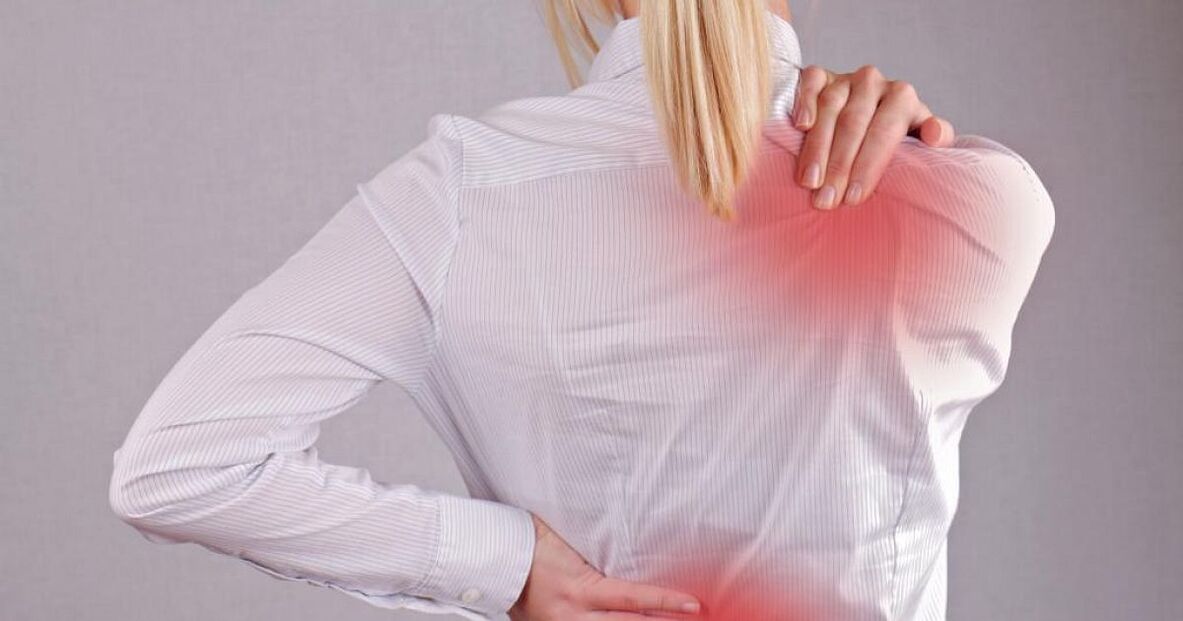
Back pain is most common in older people, but can also occur in young people for a variety of reasons.Almost all adults are used to periodically feeling pain in the back, which is explained by the special predisposition of this part of the body to various types of injuries.The vast majority of back pain can be easily treated and prevented.However, sometimes the causes of back pain can be very serious, including, for example, osteochondrosis.
Back pain can also be caused by any disease of the gastrointestinal tract, the presence of kidney stones, or other problems with the human urinary system.
Back pain can occur either in the lumbar area or between the shoulder blades and, depending on the cause of the pain, can also cause pain in the arm or leg.
Causes of back pain
The main causes of back pain include diseases such as osteochondrosis, spondyloarthrosis, radiculopathy, scoliosis, herniated disc, osteoporosis, myofascial pain and serious disorders of spinal circulation.
In addition, back pain can be caused by excess weight, heavy physical activity, including that involving heavy lifting, poor posture, or an infection.
Factors contributing to back pain
When back pain is caused by an illness but there is no treatment, the pain tends to come back and subside depending on what contributing factors.The recurrence of back pain can be triggered, for example, by hypothermia or heavy lifting, as well as by spending a long time in an uncomfortable position.In addition, infection can cause pain in the body.
Main symptoms of back pain
A signal to see a doctor and undergo an examination is back pain that does not go away within 3-5 days, as well as if the accompanying body temperature is above 37.8.
Back pain may be accompanied by frequent and painful urination, vomiting and nausea, numbness in the limbs, and diarrhea.These are all symptoms that should prompt you to see your doctor immediately.
If, in addition to back pain, you also experience noticeable difficulty moving your arms or legs as well as confusion, it is extremely important to see a doctor as quickly as possible.
Diagnosis of back pain
For back pain, examination methods such as neurological and X-ray examinations, CT and MRI as well as manual diagnostics are used.
Most often, osteochondrosis is detected during an X-ray examination of elderly people.
Immediately after the doctor's visit, an anamnesis is taken, symptoms and complaints are clarified in detail and further examinations are then prescribed.
When drawing up an anamnesis, the localization of pain, its radiation, the emotional state of the patient are clarified and the presence of a connection between the occurrence of pain and the person's position is revealed.The presence of old back injuries is also important.
To determine the presence of neoplasms and infections, a somatic examination is performed.
Treatment of back pain
To treat pain of different types, depending on the cause, treatment methods such as manual, drug and physical therapy, as well as exercise therapy, postisomeric relaxation, surgery, traction, interspinous and paravertebral blocks are prescribed.In addition, compliance with orthopedically correct therapy is essential.
When treating osteochondrosis, it is necessary to avoid sudden movements and especially bending over and to move mainly at rest.In case of acute osteochondrosis, the patient is not allowed to go to a medical institution and undergo treatment at home.In this case, non-steroidal anti-inflammatory drugs, analgesics and muscle relaxants are prescribed and it is recommended to sleep on a hard bed and use special protection under the mattress.
In the treatment of intervertebral hernias, surgical intervention is used if the patient experiences compression of the spinal cord, which is quite rare.
Chronic back pain
The presence of chronic back pain often indicates osteochondrosis, the treatment of which takes from 5 to 15 sessions, depending on the intensity of the pain.The treatment process includes acupuncture, vacuum therapy, acupressure, moxotherapy, hirudotherapy and stone therapy.
If we dwell on each of the listed methods in more detail, we can note the good effectiveness of acupressure, which helps to eliminate muscle spasms, excessive tension, and promotes blood circulation.Thanks to manual therapy, functional disorders of the spinal joints are also effectively eliminated.And if the patient follows the doctor's recommendations after completing therapy, the intervertebral discs will continue to recover on their own.
If there is a herniated disc, the treatment is a rather lengthy process that slowly reduces the size of the herniated disc itself and relieves the pain.Complete treatment allows you to fully restore the normal functioning of the affected intervertebral disc.
























